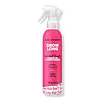What's inside
What's inside
 Key Ingredients
Key Ingredients

 Benefits
Benefits

 Concerns
Concerns

 Ingredients Side-by-side
Ingredients Side-by-side

Water
Skin ConditioningAmodimethicone
Glycerin
HumectantPEG-12 Dimethicone
Skin ConditioningPropylene Glycol
HumectantPvp
Emulsion StabilisingParfum
MaskingPolysorbate 20
EmulsifyingCetrimonium Chloride
AntimicrobialDMDM Hydantoin
PreservativeTrideceth-12
EmulsifyingBenzophenone-4
UV AbsorberTriethanolamine
BufferingDisodium EDTA
Hexyl Cinnamal
PerfumingBenzyl Benzoate
AntimicrobialLimonene
PerfumingButylphenyl Methylpropional
PerfumingHydrolyzed Silk
HumectantLinalool
PerfumingCitronellol
PerfumingGeraniol
PerfumingHydroxyisohexyl 3-Cyclohexene Carboxaldehyde
MaskingAlpha-Isomethyl Ionone
PerfumingAscorbic Acid
AntioxidantTocopheryl Acetate
AntioxidantPanthenol
Skin ConditioningBiotin
AntiseborrhoeicNiacinamide
SmoothingLactic Acid
BufferingWater, Amodimethicone, Glycerin, PEG-12 Dimethicone, Propylene Glycol, Pvp, Parfum, Polysorbate 20, Cetrimonium Chloride, DMDM Hydantoin, Trideceth-12, Benzophenone-4, Triethanolamine, Disodium EDTA, Hexyl Cinnamal, Benzyl Benzoate, Limonene, Butylphenyl Methylpropional, Hydrolyzed Silk, Linalool, Citronellol, Geraniol, Hydroxyisohexyl 3-Cyclohexene Carboxaldehyde, Alpha-Isomethyl Ionone, Ascorbic Acid, Tocopheryl Acetate, Panthenol, Biotin, Niacinamide, Lactic Acid
Water
Skin ConditioningCetyl Alcohol
EmollientBehentrimonium Chloride
PreservativeParfum
MaskingPhenoxyethanol
PreservativeCaffeine
Skin ConditioningTocopheryl Acetate
AntioxidantPanax Ginseng Root Extract
EmollientBiotin
AntiseborrhoeicCocos Nucifera Oil
MaskingStearyl Alcohol
EmollientPropylene Glycol
HumectantCyclopentasiloxane
EmollientDivinyldimethicone/Dimethicone Copolymer
Isopropyl Alcohol
SolventAmodimethicone
Ethylhexylglycerin
Skin ConditioningC12-13 Pareth-3
EmulsifyingCetrimonium Chloride
AntimicrobialTrideceth-12
EmulsifyingC12-13 Pareth-23
CleansingButylene Glycol
HumectantSodium Hydroxide
BufferingWater, Cetyl Alcohol, Behentrimonium Chloride, Parfum, Phenoxyethanol, Caffeine, Tocopheryl Acetate, Panax Ginseng Root Extract, Biotin, Cocos Nucifera Oil, Stearyl Alcohol, Propylene Glycol, Cyclopentasiloxane, Divinyldimethicone/Dimethicone Copolymer, Isopropyl Alcohol, Amodimethicone, Ethylhexylglycerin, C12-13 Pareth-3, Cetrimonium Chloride, Trideceth-12, C12-13 Pareth-23, Butylene Glycol, Sodium Hydroxide
 Reviews
Reviews

Ingredients Explained
These ingredients are found in both products.
Ingredients higher up in an ingredient list are typically present in a larger amount.
This water-soluble silicone is used for its hydrating and softening properties. It is used to add a silky feel to skincare products and has great benefits for haircare.
In haircare, this ingredient:
- Adds shine
- Protects color
- Offers thermal protection
- Boosts hair strength
- Does not build up as easily
Biotin is a B vitamin that is naturally produced by our bodies. It is also called Vitamin H.
Our bodies use biotin in the metabolism process. It also helps our bodies use enzymes and move nutrients around. A biotin deficiency can lead to brittle hair and nails.
More research is needed on applying biotin topically. However, taking biotin orally has been shown to help nourish the skin, hair, and nails. They play a role in forming skin-hydrating fatty acids.
Biotin is water-soluble. It can be found in foods such as fish, eggs, dairy, nuts, and meat. Vitamin H stands for "haar" and "haut". These are the German words for hair and skin.
Learn more about BiotinThis ingredient is a preservative, antimicrobial, and emulsifier. It is often used in cosmetics for its ability to cleanse, condition, and reduce static.
Cetrimonium chloride is a quaternary ammonium salt, meaning it has a water-soluble structure.
Parfum is a catch-all term for an ingredient or more that is used to give a scent to products.
Also called "fragrance", this ingredient can be a blend of hundreds of chemicals or plant oils. This means every product with "fragrance" or "parfum" in the ingredients list is a different mixture.
For instance, Habanolide is a proprietary trade name for a specific aroma chemical. When used as a fragrance ingredient in cosmetics, most aroma chemicals fall under the broad labeling category of “FRAGRANCE” or “PARFUM” according to EU and US regulations.
The term 'parfum' or 'fragrance' is not regulated in many countries. In many cases, it is up to the brand to define this term.
For instance, many brands choose to label themselves as "fragrance-free" because they are not using synthetic fragrances. However, their products may still contain ingredients such as essential oils that are considered a fragrance by INCI standards.
One example is Calendula flower extract. Calendula is an essential oil that still imparts a scent or 'fragrance'.
Depending on the blend, the ingredients in the mixture can cause allergies and sensitivities on the skin. Some ingredients that are known EU allergens include linalool and citronellol.
Parfum can also be used to mask or cover an unpleasant scent.
The bottom line is: not all fragrances/parfum/ingredients are created equally. If you are worried about fragrances, we recommend taking a closer look at an ingredient. And of course, we always recommend speaking with a professional.
Learn more about ParfumPropylene Glycol is an odorless, colorless liquid. As a humectant, it helps skin retain moisture. It also aids in delivering active ingredients.
Another role of this ingredient is preventing a product from melting or freezing. Propylene glycol also adds antimicrobrial properties to a product, elongating product lifespan.
This ingredient is considered an organic alcohol and commonly added into both cosmetics and foods.
Those with sensitive skin or conditions may develop a rash when using this ingredient.
Learn more about Propylene GlycolTocopheryl Acetate is AKA Vitamin E. It is an antioxidant and protects your skin from free radicals. Free radicals damage the skin by breaking down collagen.
One study found using Tocopheryl Acetate with Vitamin C decreased the number of sunburned cells.
Tocopheryl Acetate is commonly found in both skincare and dietary supplements.
Learn more about Tocopheryl AcetateWe don't have a description for Trideceth-12 yet.
Water. It's the most common cosmetic ingredient of all. You'll usually see it at the top of ingredient lists, meaning that it makes up the largest part of the product.
So why is it so popular? Water most often acts as a solvent - this means that it helps dissolve other ingredients into the formulation.
You'll also recognize water as that liquid we all need to stay alive. If you see this, drink a glass of water. Stay hydrated!
Learn more about Water